iotum's Talk-Now is now available!
March 2007
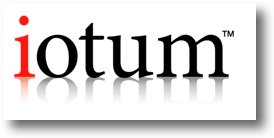
In a previous post The magic of ´┐Żpresence´┐Ż, I talked about the concept of presence in relation to telecommunications services and looked at different examples of how it had been implemented in various products.
One of the most interesting companies mentioned was iotum, a Canadian company. iotum had developed what they called a relevance engine which enabled the provision of ability to talk and willingness to talk information into a telecom service by attaching it to appropriate equipment such as a Private Branch Xchanges (PBX) or a call centre Automatic Call Distribution (ACD) managers.
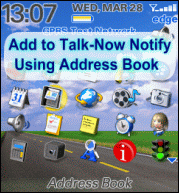 One of the biggest challenges for any
company wanting to translate presence concepts into practical services is how to make it useable rather than just being just a fancy concept that is used to describe a of a number peripheral and
often unusable features of a service. Alec Saunders, iotum's founder, has been articulating his ideas about this in his blog
Voice 2.0: A Manifesto for the Future. Like all companies that have their genesis in the IT and applications world, Alec believes that "Voice 2.0 is a user-centric view of the world...
"it´┐Żs all about me" ´┐Ż my applications, my identity, my availability."
One of the biggest challenges for any
company wanting to translate presence concepts into practical services is how to make it useable rather than just being just a fancy concept that is used to describe a of a number peripheral and
often unusable features of a service. Alec Saunders, iotum's founder, has been articulating his ideas about this in his blog
Voice 2.0: A Manifesto for the Future. Like all companies that have their genesis in the IT and applications world, Alec believes that "Voice 2.0 is a user-centric view of the world...
"it´┐Żs all about me" ´┐Ż my applications, my identity, my availability."
And rather controversially, if you come from the network or the mobile industry: "Voice 2.0 is all about developers too ´┐Ż the companies that exploit the platform assets of identity, presence, and call control. It´┐Żs not about the network anymore." Oh by the way, just to declare my partisanship, I certainly go along with this view and often find that the stove-pipe and closed attitudes sometimes seen in mobile operators is one the biggest hindrances to the growth of data related applications on mobile phones.
There is always a significant technical and commercial challenge to OEMing platform-based services to service providers and large mobile operators so the launch of a stand-alone service that is under complete control of iotum is not a bad way to go. Any business should have to full control of their own destiny and the choice of the relatively open Blackberry platform gives iotum a user base they can clearly focus on to develop their ideas.
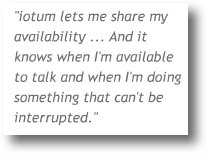 iotum launched the beta version of Talk-Now
in January and provides a set of features that are aimed at helping Blackberry users to make better use of the device that the world has become addicted to using in the last few years. Let's talk
turkey, what does the Talk-Now service do?
iotum launched the beta version of Talk-Now
in January and provides a set of features that are aimed at helping Blackberry users to make better use of the device that the world has become addicted to using in the last few years. Let's talk
turkey, what does the Talk-Now service do?
According to web site, as seen in the picture on the left, it provides a simple-in-concept bolt-on service for Blackberry phone users to see and share their availability status to other users.
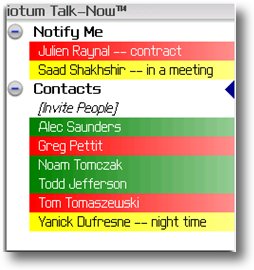 At the in-use end of the service, the
Talk-Now service interacts with a Blackberry user's address book by adding colour coding to contact names to show the individual's availability. On initial release only three colours were used,
white, red and green.
At the in-use end of the service, the
Talk-Now service interacts with a Blackberry user's address book by adding colour coding to contact names to show the individual's availability. On initial release only three colours were used,
white, red and green.
Red and and green clearly show when a contact is either Not-Available or Available, I'll talk about white in a minute. Yellow was added later, based on user feedback, to indicate an Interruptible status.
The idea behind Talk-Now is that helps users reduce the amount of time they waste in non-productive calls and leaving voicemails. You may wonder how this availability guidance is provided by users. A contact with a white background provides the first indication of how this is achieved.
Contacts with a white background are not Talk-Now users so their availability information is not available (!) so one of the key features of the service is an Invite People process to get them to use Talk-Now and see your availability information.
If you wish a non-Talk-Now contact to see your availability, you can select their name from the contact list and send them an "I want to talk with you" email. This email will provide a link to an Availability Page as shown below. This email talks about the benefits of using the service (I assume) and asks you to use the service. This is a secure page that is only available to that contact and for a short time only.
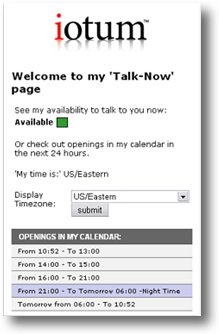
Once a contact accepts the invite and signs up to the service, you will be able to see their availability - assuming that they set up the service.
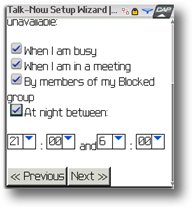 So, how do you indicate your availability?
This is set up with a small menu as shown on the left. Using this you can set up status information.
So, how do you indicate your availability?
This is set up with a small menu as shown on the left. Using this you can set up status information.
Busy: set your free/busy status manually from your BlackBerry device
In a meeting: iotum Talk-Now synchronizes with your BlackBerry calendar to know if you are in a meeting.
At night: define which hours you consider to be night time.
Blocked group: you can add contacts to the ´┐Żblocked´┐Ż group.
You can also set up VIPs (Very Important Persons) who are individuals who receive priority treatment. This category needs to be used with care. Granting VIP status to a group overrides the unavailability settings you have made. You can also define Workdays. Some groups might be VIPs during work hours, while other groups might get VIP status outside of work. This is designed to help you better manage your personal and business communications.

There is also a feature whereby you can be alerted when a contact becomes available by a message being posted on your Blackberry as shown on the right.
Many of the above setting can be set up via a web page, for example:
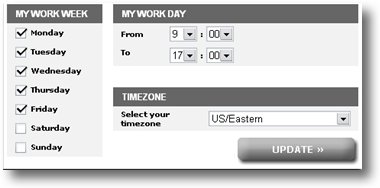
Setting your working week
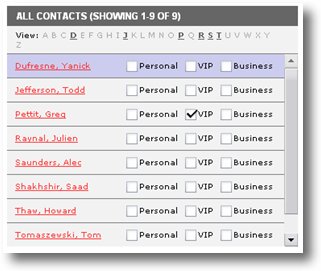
Setting contact groups
However, it should be remembered that like Plaxo and LinkedIn, this web based functionally does require you to upload - 'synchronise' - your Blackberry contact list to the iotum server and many Blackberry users might object to this. It should be noted as well that the calendar is accessed as well to determine when you are in meetings and deemed busy.
Talk-Now looks to be an interesting and well thought out service. Following traditional Web 2.0 principles, the service is provided for free today with the hope that iotum will be able to charge for additional features at a future date.
I wish them luck in their endeavours and will be watching intensely to see how they progress in coming months.
